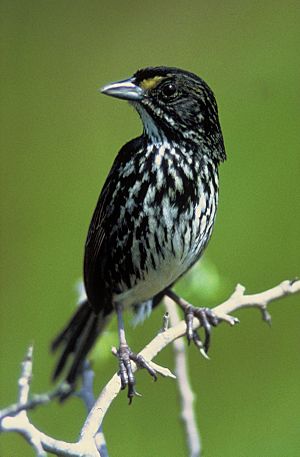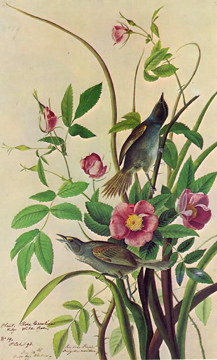Dusky seaside sparrow facts for kids
Quick facts for kids Ammospiza maritima nigrescens |
|
|---|---|
 |
|
| Conservation status | |
| Scientific classification |
|
| Kingdom: | Animalia |
| Phylum: | Chordata |
| Class: | Aves |
| Order: | Passeriformes |
| Family: | Passerellidae |
| Genus: | Ammospiza |
| Species: | |
| Subspecies: |
†A. m. nigrescens
|
| Trinomial name | |
| Ammospiza maritima nigrescens (Ridgway, 1873)
|
|
The dusky seaside sparrow (Ammospiza maritima nigrescens) was a special kind of seaside sparrow. It lived only in the salt marshes of Merritt Island and along the St. Johns River in Florida. This sparrow did not migrate, meaning it stayed in one place. Sadly, the very last known dusky seaside sparrow died in 1987. It was officially declared extinct in December 1990.
Discovering the Dusky Sparrow
The dusky seaside sparrow was first found on March 17, 1872. A scientist named Charles Johnson Maynard discovered it. In 1873, it was officially named a subspecies. It had a dark color and a unique song. These features made it different from other seaside sparrows.
This sparrow lived only in the marshes of Florida's Atlantic Coast. It was found on Merritt Island and near the upper St. Johns River. Because of where it lived, it was separated from other seaside sparrows. By 1981, only five dusky seaside sparrows were left. All of them were males.
Why the Dusky Sparrow Disappeared

Many things led to the extinction of the dusky seaside sparrow. One big problem was when Merritt Island was flooded. This was done to reduce the number of mosquitoes near the Kennedy Space Center. But it destroyed the sparrows' nesting places. Their numbers dropped very quickly.
Later, the marshes around the river were drained. This happened to build highways. It also made way for sugar and oil industries. This caused even more harm to the sparrows. Over time, pollution and chemicals called pesticides also hurt them. By 1979, only six dusky seaside sparrows were known to be alive. All of them were males. The last female was seen in 1975.
The Last Dusky Sparrows
In 1979, a plan was approved to try and save the sparrows. Scientists wanted to breed the remaining dusky seaside sparrows. They would breed them with Scott's seaside sparrow (A. m. peninsulae). These Scott's sparrows lived on Florida's gulf coast.
By 1980, five dusky seaside sparrows were at a special breeding center. It was in Gainesville, Florida. One of these sparrows had an orange leg band. This bird was very special.
In 1983, the last four dusky seaside sparrows were moved. They went to the Walt Disney World Resort. They lived in a safe place on Discovery Island. The goal was to continue the breeding program there. By March 31, 1986, only "Orange Band" was left.
"Orange Band" lived a very long time for a sparrow. It was at least nine years old, maybe even thirteen. It died on June 17, 1987. After "Orange Band" died, there were no more pure dusky seaside sparrows. The breeding program was stopped. This was because scientists thought the mixed-breed sparrows could not create pure dusky sparrows. Sadly, the remaining mixed-breed sparrows either died or escaped. This led to the final extinction of the dusky seaside sparrow.



